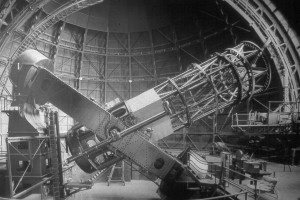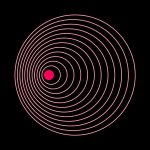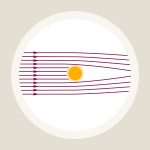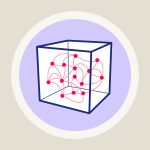Cosmology / Elementary Tour part 2: Reddening galaxies
Cosmic expansion has consequences for the light that reaches us from far-away galaxies – consequences that, in the 1920s, set astronomers on the track of an expanding universe in the first place.
For an exact description of these effects, one would need a geometrical picture of the universe’s expansion. This is the proper way to do things in general relativity, in any case. However, for galaxies not too far away, one can find an approximate explanation that views expansion not as a geometric effect, but as ordinary motion of the galaxies in question. We’ve already used this approximation on the previous page to “derive” the Hubble relation.
For galaxies literally moving away, we can bring into play what’s called the Doppler effect. Many readers will know this effect from everyday life. Imagine you’re standing on the sidewalk, and there’s a fire truck racing towards you on the street, lights flashing, horns blaring. The moment it passes you before rushing on to wherever its going, you can hear the pitch of its horn change quite suddenly. Whatever sounds the receeding fire truck is making, they sound much deeper to your ear than when it was approaching. For light from moving objects, there is an exactly effect – a frequency shift towards higher frequencies (corresponding to a higher pitch, for sound-waves) if the light-source moves towards us, and to lower frequencies (lower pitch) if it moves away from us. For light, the shift towards higher frequencies is a shift towards the blue end of the spectrum, while a shift towards lower frequencies is a shift towards the red end, called a red-shift.
With galaxies moving away from us systematically due to cosmic expansion, this would lead us to expect that astronomers should observe the light of these galaxies to be red-shifted – and as the speed with which a galaxy recedes increases with distance, this red-shift should increase as we look at more and more distant galaxies. This is indeed the case.
The following photograph shows the 100 inch telescope at Mount Wilson observatory, California:
With this telescope, Edwin Hubble discovered the systematic correlation between the distances and red-shifts of far-away galaxies which led physicists to conclude that our universe is expanding.
For galaxies that are extremely far away, the simple Doppler shift model is inappropriate. For them, it’s important that the cosmological red-shift is not so much a Doppler shift but the fact that cosmic expansion stretches all light-waves that make their way to us from distant light sources. This stretching also corresponds to a red-shift, and there is still a relationship between red-shift and distance, but it is somewhat more complicated than in the Doppler shift model. The details, it turns out, depend on certain parameters of the cosmological model, such as the average density of the whole universe, and that’s quite exciting: by measuring red-shifts and distances, we can measure parameters that describe our cosmos as a whole! Once the parameters are fixed by these and other measurements, one can make further predictions – for instance: how many galaxies can one expect to find at a certain distance from our own? These predictions allow tests of the cosmological models, and so far, Einstein-based cosmology has passed all these tests.
The most precise tests (and the most precise ways to fix parameters) emerge from the models’ predictions for our universe’s fiery past – more about that on the next page: The early universe.











